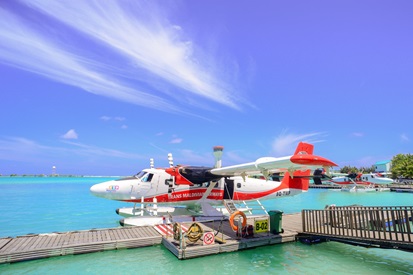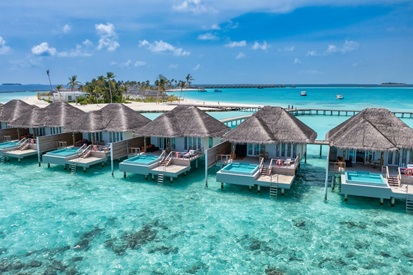

The best diving spots, prices, and types of diving: everything you need to know about scuba diving in the Maldives archipelago.

Depositphotos
Best Time for Diving in Maldives
Whale sharks, manta rays, colorful fish of all varieties, mysterious caves, and thrilling explorations of sunken ships – all this is the underwater kingdom of the Maldives. Moreover, diving in the Indian Ocean is available year-round. However, diving conditions vary depending on the season:
- November to April (dry season): the best time for diving, with calm seas, excellent visibility, and a large number of marine inhabitants.
- May to October (wet season): a period of plankton bloom that attracts manta rays and whale sharks but slightly reduces visibility.

Depositphotos
Diving in the Maldives: Features
The Maldives archipelago offers a vast variety of dive sites, from shallow reefs to deep underwater canyons and shipwrecks. Here, divers can find everything their heart desires. Reasons why the Maldives attract diving enthusiasts include:
- Water transparency can reach 30-40 meters, providing an excellent opportunity to witness the underwater kingdom in all its splendor!
- Water temperature of +26-30°C year-round.
- Magnificent reefs and rich marine life. In the Maldives, you can encounter whale sharks – the largest sharks in the world, sometimes reaching 18 meters – as well as giant manta rays, reef sharks, sea turtles, dolphins, and moray eels. And, of course, the waters are teeming with colorful tropical fish.
- Diverse dive sites. The Maldives offer dive sites suitable for all experience levels. Coral reefs are ideal for beginners, often located in shallow waters. Deep canyons and underwater islands are perfect for experienced divers who can explore the depths and meet large marine creatures. There are also shipwrecks in the Maldives, allowing you to swim inside vessels that sank decades ago.
- Drift diving with moderate to strong currents, depending on the location and season.

Depositphotos
Types of Diving in the Maldives
Wreck Diving
Sunken ships and even an airplane have become tourist attractions in the Maldives, now favored by divers. These sunken objects form the basis for artificial reefs and attract numerous sea creatures. Some were deliberately sunk. Coral colonies grow around these ships, hosting various fish species (reef sharks, butterflyfish, angelfish, sea turtles). Among the most famous sunken objects:
- Rannamaari – a sunken sand-mining vessel that has become a home for corals.
- MV Kuredu Express – a former passenger ferry deliberately sunk to create an artificial reef.
- Airplane wreck near Maldives – the remains of a crashed plane.
Before diving, it’s essential to undergo a briefing and, if needed, a certification course for deeper dives (e.g., Advanced Open Water Diver or Deep Diver). Specialized equipment, such as underwater lights and additional oxygen, is also required.

Depositphotos
Swimming with Sharks
To swim with sharks in the Maldives, you can purchase a diving tour or book a special excursion. Most resorts and dive centers offer such programs. Diving experience isn’t necessary, as sharks can be encountered even in shallow waters using a mask and snorkel. Such swims are generally safe, but basic safety rules must be followed: avoid sudden movements, don’t touch the sharks, don’t feed them, and avoid using flash photography.
The most exciting journey, however, is to the islands of the Baa and South Ari atolls. These corners of the Maldives are where you can meet sea giants. Huge whale sharks and manta rays are incredible marine creatures, the very spectacle that draws divers from around the world to the Maldives.
Where to Stay to Watch Whale Sharks
- Lily Beach Resort & Spa
- Dusit Thani Maldives
- Amilla Fushi
- Four Seasons Resort Maldives at Landaa Giraavaru

Depositphotos
Night Dives
At night, the reefs come alive: predators go hunting, and rare fish species appear. These dives offer incredible emotions, as corals transform under the glow of underwater lights!

Depositphotos
Dive Safari in the Maldives
These are sea cruises on specially equipped diving vessels. On board, you’ll find all the amenities for a comfortable stay and diving: a team of experienced instructors, diving equipment, restaurants, cabins, and even spas. Such safaris can last from one day (returning to the hotel in the evening) to several weeks, depending on the chosen route.
Throughout the trip, you dive in the most picturesque locations in the Maldives. The best conditions for such trips in the central atolls are from November to April. All central atoll routes begin and end in Male. Simply fly to the Maldives, and a boat representative will meet you at the airport to prepare you for boarding.
Popular routes include:
- Ari Atoll – renowned for manta ray sightings, whale sharks, and an abundance of reef sharks.
- Baa Atoll – a UNESCO Biosphere Reserve where you can encounter whale sharks, manta rays, and other rare marine species. For a spectacular trip, book a cruise between June and October, during a full or new moon.
- Lhaviyani Atoll – a place for deeper dives and encounters with rare marine creatures.
- South Ari Atoll – famous for its abundance of reef sharks and opportunities for diving with manta rays.

Depositphotos
Best Diving Spots in the Maldives
Shark Diving, Fuvahmulah
Perhaps one of the most renowned dives in the Maldives. In Fuvahmulah, you can swim with tiger sharks. These formidable predators can be found year-round at depths of less than 10 meters. Due to the abundance of sharks, this place is called Tiger Zoo. This dive is suitable for divers of all skill levels. There’s also a chance to see thresher sharks, mola mola, and many manta rays, which frequent this corner of the Maldives. Diving with sharks in the Maldives is generally safe, with most sharks, including reef and whale sharks, being harmless to humans, and divers are accompanied by experienced guides.
Fish Head, North Ari Atoll
Fish Head (also known as Shark Point or Mushimasmingili Thila) is considered one of the world’s best dive sites by many. Home to grey reef sharks, guitar sharks, barracudas, tuna, and more, Fish Head is a pinnacle that drops to about 35 meters, revealing mysterious caves and overhangs accessible to advanced divers.
Maaya Thila, South Ari Atoll
Ideal for beginner divers and snorkelers, this dive site boasts vibrant corals and an abundance of whitetip reef sharks, grey reef sharks, triggerfish, nudibranchs, and, if you’re lucky, a giant frogfish. The pinnacle drops to 30 meters, with weak currents, making it suitable for intermediate divers.
Sun Island, South Ari Atoll
If you want to dive with whale sharks, head to Sun Island. With a maximum depth of just 10 meters, this spot offers a great opportunity to observe sea giants. It’s accessible to divers of all skill levels and also ideal for snorkeling with a mask.
Wattaru Reef, Vaavu Atoll
Divers of all skill levels can drift along gentle currents, spotting whitetip reef sharks, Napoleon wrasses, turtles, and other creatures. More advanced divers can explore deeper overhangs at 30 meters, where they might encounter a hammerhead shark.
Banana Reef, North Male
A famous site with numerous caves, named for its curved shape. Banana Reef offers something for everyone: sloping walls, cracks, crevices, rich coral carpets, and vibrant marine life. Dives can reach up to 30 meters. Napoleon wrasses, snappers, and moray eels are frequent visitors to this dive spot.
Kandooma Thila, South Male
Kandooma Thila is home to barracudas, grey reef sharks, snappers, and many other colorful fish. This dive site is suitable for advanced divers who enjoy strong currents.
Kuredu Express, Lhaviyani Atoll
This sandy channel is known for strong currents, allowing divers to see barracudas, eagle rays, and various shark species swimming by, all amid vibrant, fantastic corals.
Miyaru Kandu, Felidhoo Island
Miyaru Kandu is the best diving spot in the Maldives for spotting hammerhead sharks. You’ll also see other large pelagic fish, such as dogtooth tuna and grey reef sharks. The best observation point is a dive to about 30 meters.
Kuda Giri Wreck, South Male
The Kuda Giri Wreck is an artificial site created by a sunken cargo ship on the edge of a coral reef. A “two-in-one” spot for lovers of shipwrecks and vibrant coral gardens. Depth range: 15-30 meters.

Depositphotos
Diving Training in the Maldives
Thanks to moderate currents, the Maldives is an excellent place to learn diving. It’s easy to master basic diving skills, such as equipment handling, underwater breathing, and safety. For experienced divers, advanced courses are available, including deep dives, night dives, and wreck dives.
You can take courses meeting all international certification standards, such as PADI and SSI. Resorts have instructors certified by international organizations. Beginners can take the Open Water Diver course, the initial certification. For those looking to deepen their skills, Advanced Open Water Diver and Rescue Diver courses are available. Experienced divers can pursue Dive Master and Instructor courses to become professional instructors.
Specialized courses include Enriched Air Diver (diving with nitrox), Drift Diver (mastering currents), Wreck Diver (sunken ships), and underwater photography.
How to Choose a Resort with Diving Courses
When selecting a resort for diving training in the Maldives, consider these factors:
- Availability of certified instructors.
- Resort ratings and reviews from other clients.
- Training conditions: pools, classrooms, and necessary equipment.
- Types of dives offered: night, cave, or wreck dives.
For diving training in the Maldives, consider these resorts:
- Vakkaru Maldives – ideal for those wanting to learn diving in a unique environment, with opportunities to dive in deep lagoons and see various marine species, including sharks and manta rays.
- Lily Beach Resort – offers excellent courses for beginners and professionals, with dives in the diverse reefs of South Ari Atoll.
- Amilla Fushi – provides courses for beginners and advanced divers, with excellent conditions for diving in the Blue Hole and other unique locations.
- Kuramathi Maldives – for those who want to learn diving and immediately practice on one of the Maldives’ most beautiful reefs.

Kuramathi Maldives
Kids’ Diving in the Maldives
According to PADI rules, children can start diving from age 8. Several programs cater to different age groups, requiring prior parental consent for participation.
- PADI Bubblemaker Program (from 8 years old): A course where children learn diving basics (proper underwater breathing, using basic equipment). Classes take place in a pool or shallow water, with a diving depth not exceeding 2 meters. Some dive centers organize Bubblemaker parties – fun events with diving elements, filled with games and surprises.
- PADI Junior Open Water Diver Program (from 10 years old): More serious training with full certification, allowing dives up to 12 meters with an experienced instructor.

Finolhu Baa Atoll Maldives
Cost of Diving in the Maldives
The Maldives has a wide range of prices. You can dive at the same spot in a group but pay differently. Prices for excursions at resorts are always higher than on local islands.
Diving at Resorts
Costs depend on the resort, with luxury hotels often setting high prices for their services. It’s challenging to provide a single cost for the Maldives. On average, diving costs:
- Introductory dive: from $50. Some hotels offer a free trial dive.
- 6-dive pass: about $300, excluding equipment rental and training.
- Equipment rental: from $20 per set.
- Diving training: from $200. Obtaining a PADI Open Water Diver certificate costs approximately $450–500.
Prices for Diving on Local Islands
On local islands with guesthouses, diving costs are generally lower, though conditions may be more modest, such as less luxurious boats or meals. However, the sea remains the same.
- Snorkeling equipment rental: from $10.
- Swimming with manta rays: about $100.
- Diving lesson with an instructor and dive: $60–80.
- Reef diving trip: up to $150.
- Swimming with sharks: from $200.

Komandoo Island Resort & Spa
Who Should Not Go Diving
Before diving, check for medical contraindications. Dive centers don’t require a health certificate, but you’ll need to sign a form stating you’re in good health and that the organizers are not liable. If you have respiratory, heart, vascular, or musculoskeletal issues, consult a doctor.
Medical check-ups are available in the Maldives. Some resorts have clinics (check when booking), or you can visit the ADK Hospital in Male. It’s crucial to purchase appropriate medical insurance. Standard insurance covers only beach holidays; for diving, choose insurance that includes various activities.

Innahura Maldives Resort
What Divers Should Know in the Maldives
- Touching corals, collecting fragments, or catching fish (even by hand) is prohibited, with fines of about $1,000 for violators.
- Avoid diving with a stuffy nose, nasopharyngeal or ear conditions, or within 12 hours before or after a flight.
- Cancel or abort a dive if you feel unwell.
- Always follow the instructor’s instructions and keep them in sight.
- Refrain from alcohol consumption the night before diving.
- Prepare for your underwater adventure in advance. Choose the dive spots you want to visit and book accommodations nearby.

Depositphotos
More articles
- Bali's Best Beach Clubs - 13 Luxury Oases
- Tips for tourists in Indonesia - how to avoid spoiled holidays
- Yoga Studios in Bali - where to catch Zen on the Island of the Gods
- Port Louis: All About Mauritius' Capital
- Seychelles Honeymoon Hotels: 9 Paradise Spots
- Bali's Best Eco-Hotels: Top 12 Spots
- Seychelles for outdoor activities - from diving to jungle trekking
- Why you can be deported from Bali - several main reasons
- Seychelles hotels with the best panoramic views
- UNESCO sites in Indonesia: temples, parks and other amazing places



